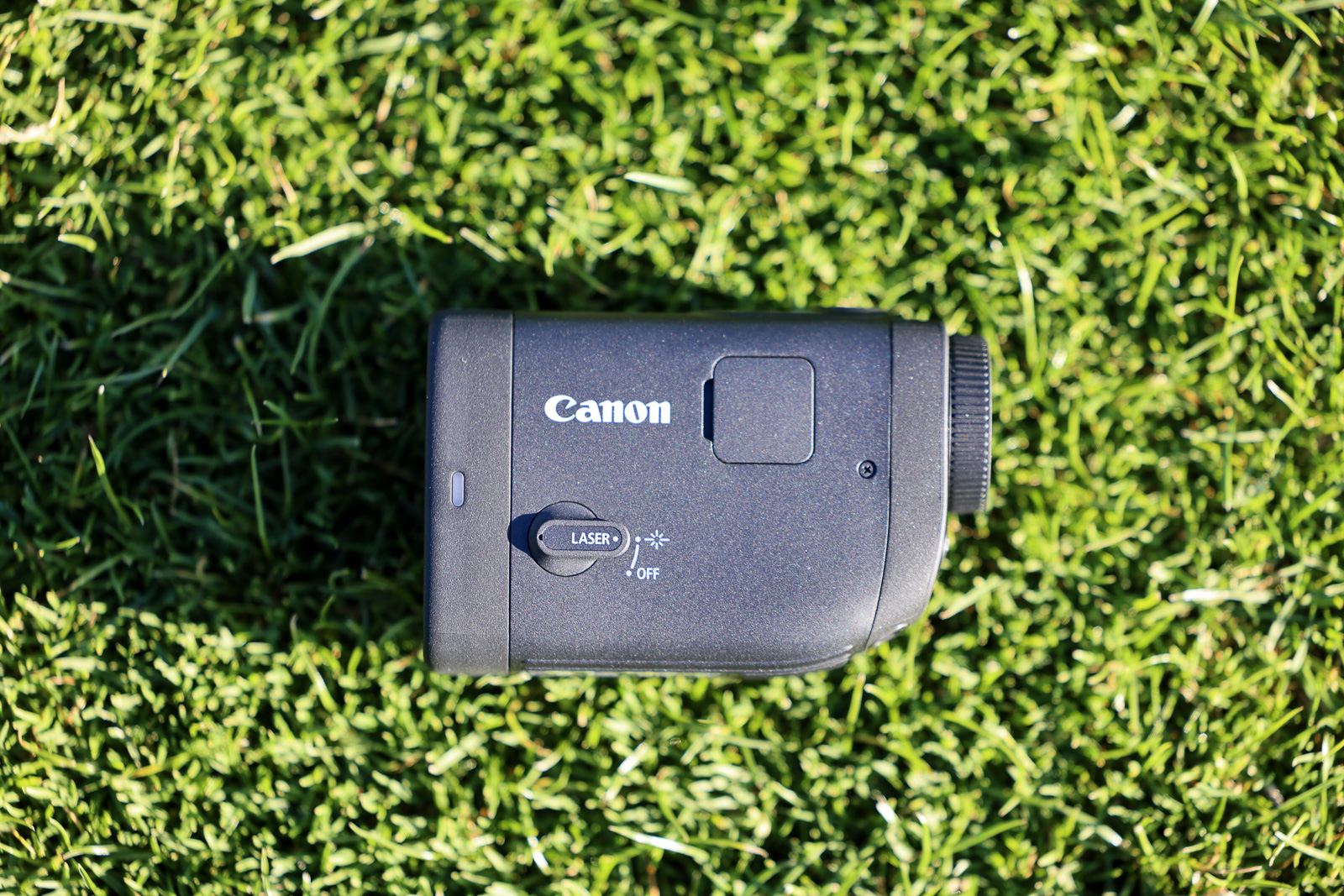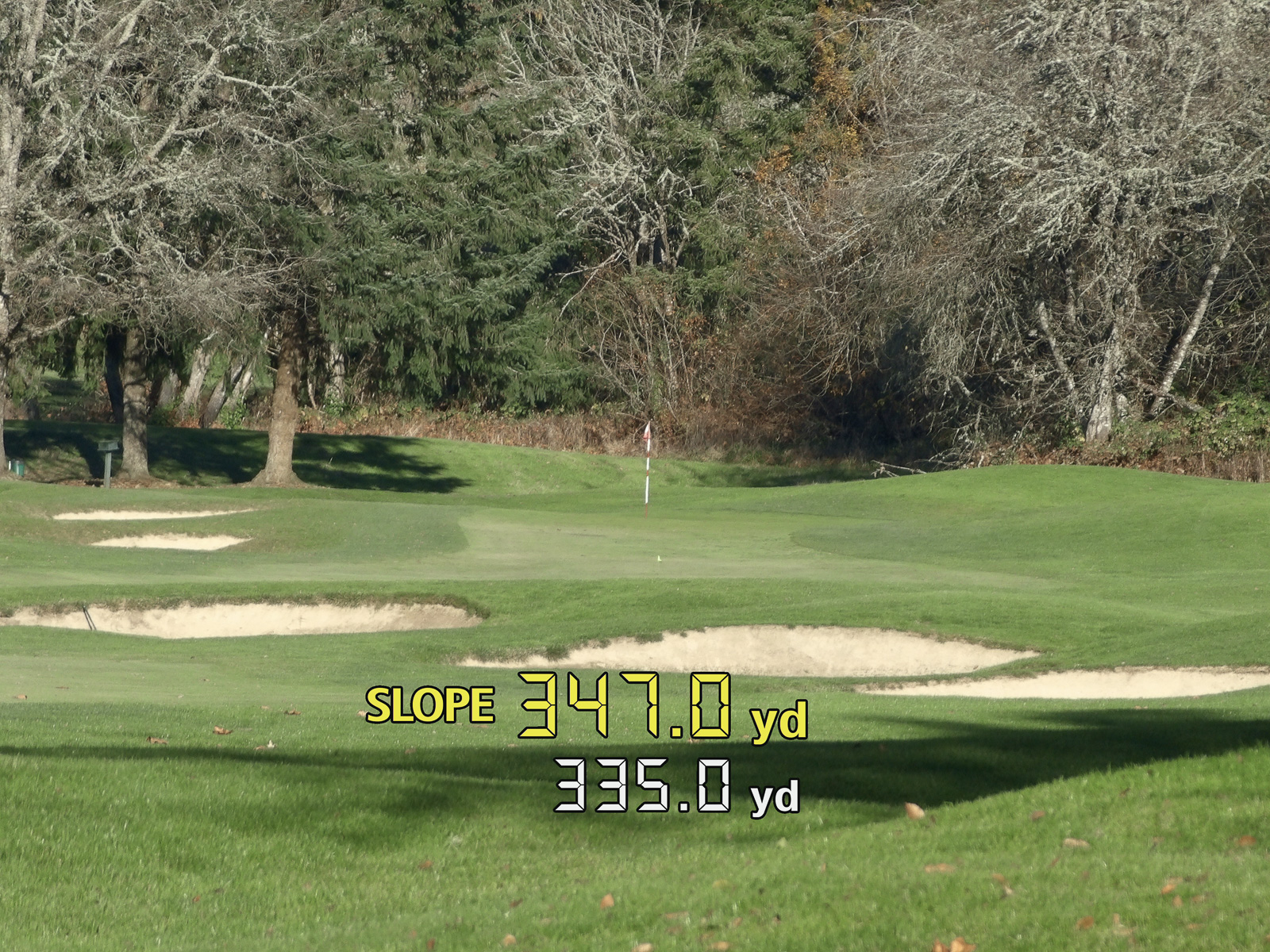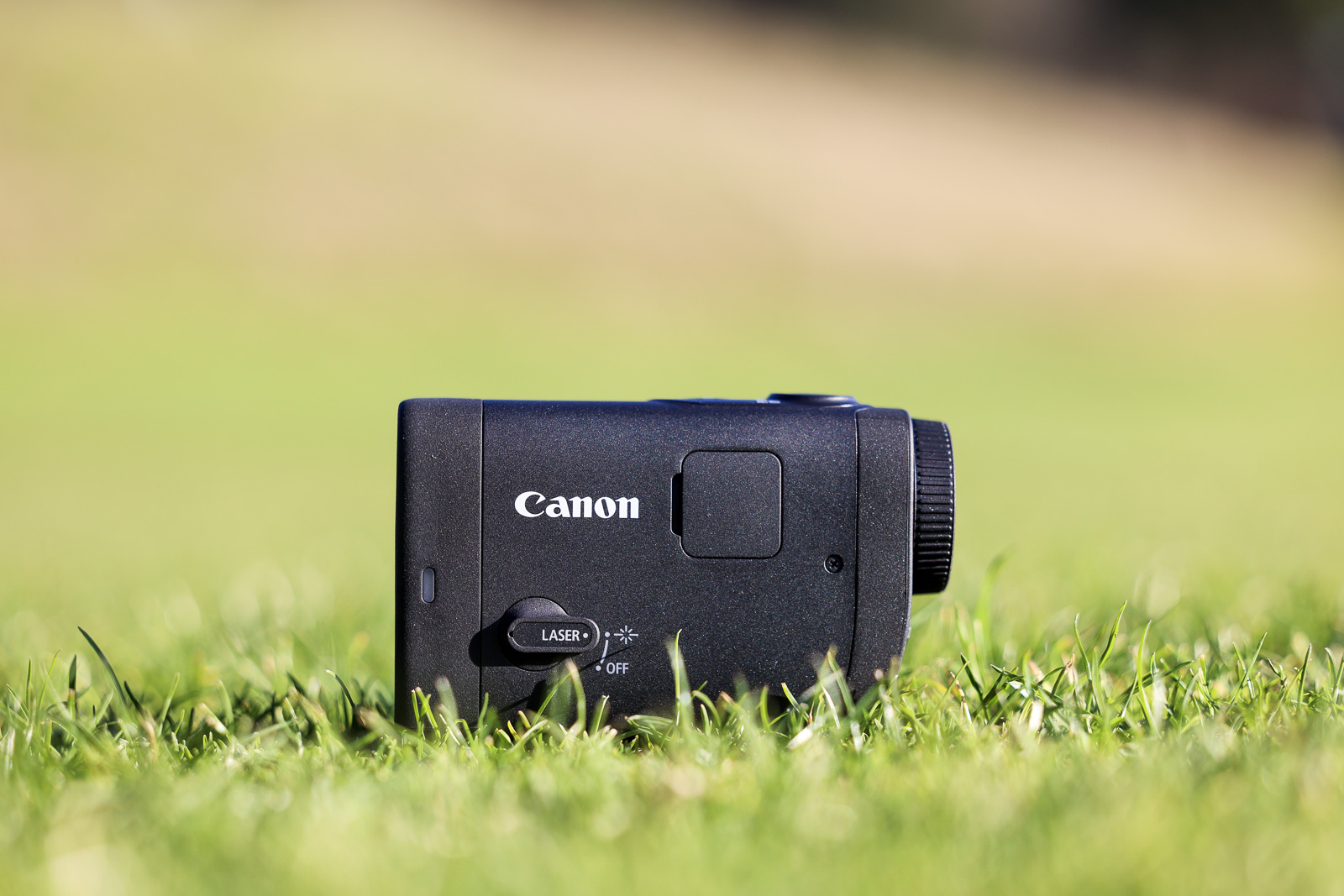Every once in a while, a golf product crosses my path that makes me stop and think, “Why does this exist?”
That’s exactly how I felt when I got my hands on the Canon PowerShot Golf Rangefinder.
It’s a mix of a laser rangefinder and a camera—a combo I didn’t see coming. As someone who has reviewed countless golf gadgets, I had to find out if this hybrid device was a stroke of genius or just something unnecessary.
Spoiler: it’s a little bit of both.
First Impressions of the Canon Powershot Golf
For the last 5 years I’ve used Canon cameras almost exclusively for both my YouTube videos as well as the photos on this site. So I was pretty excited to see if this product would live up to expectations.
The rangefinder market is saturated, with products ranging from $150 to $600 that generally aim to do the same thing: get accurate distances fast.
When I opened the box, I wasn’t blown away. There was the rangefinder itself and a canvas carrying case—no charger included.

For a $350 product that requires regular charging, this felt like an oversight. That said, the device is tiny. It’s one of the smallest rangefinders I’ve ever seen, which could appeal to players who like a minimalist, lightweight option.
Looking for an image-stabilized rangefinder that can also take photos and videos? Then this might be your only choice! Stabilization works great, but photo and video quality leaves a little to be desired.
Build Quality of the Canon Golf Rangefinder
Holding the device, it instantly feels like a Canon camera—not a typical rangefinder. The build quality leans more toward a point-and-shoot camera than something rugged for the golf course.
Which is to say, the build quality is great. It feels like a high-end Canon point-and-shoot more than a rangefinder.
While its IPX4 waterproof rating means it can handle splashes, it’s far behind competitors with IPX67 ratings that can survive full submersion.

Also similar to how you’d feel about a camera, if you were to drop it – it probably wouldn’t end well. So while it feels expensive, it doesn’t feel as durable as your typical rangefinder.
But How Does it Perform?
Let’s talk about what matters most: how well it functions as a rangefinder. And here, the Canon PowerShot delivers where it counts—sort of.
Canon’s strength in image stabilization shines through. If you’ve struggled to lock onto flags because of shaky hands, this rangefinder makes a big difference. The stabilization technology works seamlessly, helping you get accurate yardages without frustration.

Also since I’ve only tested two other image-stabilized rangefinders (the Nikon Coolshot ProII Stabilized, and the Leupold GX-6C) and both are 4+ years old, I think this is the feature that will lead the most people to buy the Powershot.
The 6x magnification is standard, but the digital zoom to 12x sets it apart—though not always in a good way. At higher zoom levels, the image gets shakier, making it harder to focus on the flag. While it’s a cool feature, it feels more like a novelty than something practical.
One convenient feature is the vibration feedback. When you lock onto the flag, the device vibrates and displays a small flag icon, giving you confidence in the reading. It works really well.
The menu system leaves a lot to be desired. Canon borrowed its camera interface, which works great on larger devices but feels cramped and unintuitive here. With four buttons controlling various functions, I often found myself clicking the wrong option or struggling to navigate quickly.
Camera Performance
Now here’s where things take a turn. The PowerShot isn’t just a rangefinder—it’s also a camera. You can capture photos and videos on the course, which sounds exciting until you actually try it.
Taking photos is simple enough, and it doesn’t interfere with the rangefinder functionality. But the image and video quality just don’t live up to Canon’s usual standards. Photos looked grainy, and videos were limited to 1080p resolution at 24 or 30 frames per second. The low frame rate means video feels choppy, especially if you’re moving the device around.
Focusing is another issue. While trying to capture a flag, I found that some shots had the flag in focus while others didn’t. It’s inconsistent at best. Combined with the minimum focus distance of 4.4 yards, don’t expect to take any close-up shots.
Considering I always have my iPhone nearby, even if I was using this as my rangefinder, I’d still probably just use my phone for photos and videos.
The quality is better, and not to mention the convenience of editing and sharing your images is lightyears better than having to download off the device.
Related: My Favorite Golf Rangefinders.
Final Thoughts on the Canon Powershot Golf
The Canon PowerShot Golf Rangefinder is undeniably unique, but it’s also a mixed bag. If you’re looking for a lightweight, well-built rangefinder with excellent image stabilization, it’s worth considering—especially if you have shaky hands. It delivers accurate readings quickly and has a sleek, compact design that stands out.
That’s who this is for.
However, the camera functionality, which should have been its standout feature, falls short. Grainy photos, low-resolution video, and awkward focus make it hard to justify relying on this over a smartphone.
For $350, you’re paying for a decent rangefinder with a quirky camera that feels more like a gimmick than a useful tool. If you’d rather have pure performance, the Nikon CoolShot remains my top recommendation—it nails the basics without complicating things.
Unless the idea of a camera-rangefinder combo really appeals to you, this might not be the upgrade you’re looking for.
Want help deciding on the best rangefinder for your game? Take my 30-second quiz to find your perfect fit: Golf Rangefinder Quiz.
Looking for an image-stabilized rangefinder that can also take photos and videos? Then this might be your only choice! Stabilization works great, but photo and video quality leaves a little to be desired.
This page contains affiliate links. This means that if you click a link and buy one of the products on this page, we may receive a commission (at no extra cost to you!) This doesn’t affect our opinions or our reviews. Everything we do is to benefit you as the reader, so all of our reviews are as honest and unbiased as possible.
The stabilization is great, however the camera features leave a lot to be desired.
If you're looking for an image stabilized rangefinder that works well, this is definitely one to consider. However the fact it's USB-C charged, not as durable as typical devices, and has a lackluster camera mode means this device didn't quite live up to my expectations that I had for it.
The Good
- Build quality is on part with what you'd expect from Canon
- Image stabilization is a great, unique feature
- Locking onto flags and using it as a rangefinder works great.
The Bad
- Doesn't include a charging cord
- Camera modes disappointed in both quality and usability
- Not as durable as other rangefinders
-
Presentation
-
Performance
-
Quality and Features
-
Price
-
Personal Affinity





